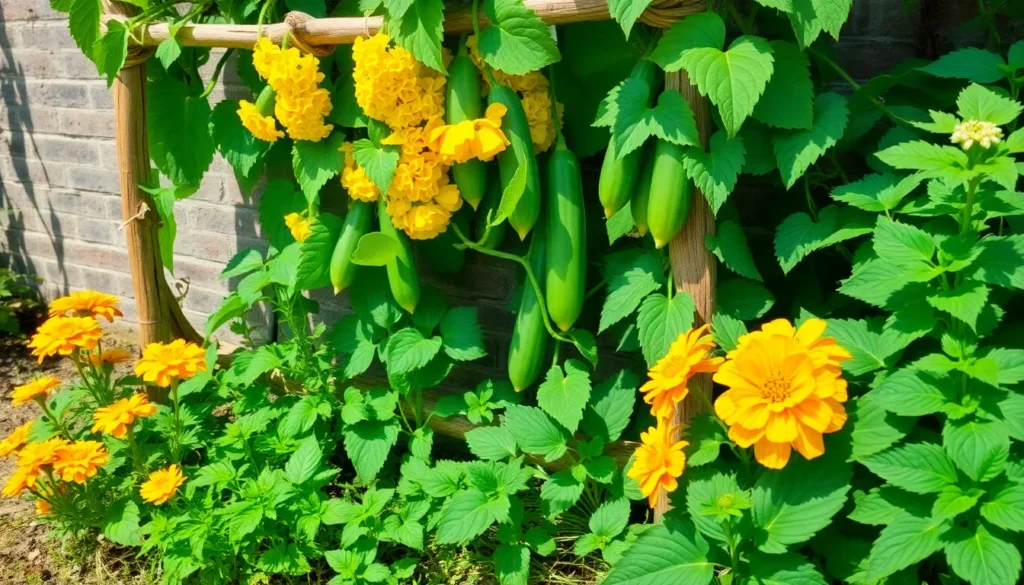Imagine stepping into your garden and witnessing a vibrant tapestry of plants, where cucumbers thrive alongside their best companions, creating a harmonious and productive ecosystem. Whether you’re just beginning your gardening journey or are a seasoned green thumb, understanding the art of companion planting can be a game-changer, elevating your garden from good to extraordinary.
In this guide, “Best Companion Plants for Cucumbers,” you’ll discover a curated list of plant pairings that not only enhance the growth of your cucumbers but also bring practical benefits like pest control and improved yields. These time-tested combinations promise to boost your confidence and inspire you to experiment, unlocking new levels of success and joy in your gardening endeavors.
By diving into these pages, you’ll gain the knowledge and techniques needed to cultivate a garden that’s not only bountiful but also a testament to the wonders of nature’s collaboration. So, let’s embark on this journey together, where the delights of companion planting await, ensuring that your cucumbers—and your gardening spirit—flourish like never before!
Marigolds (Pest-Repelling Powerhouses)
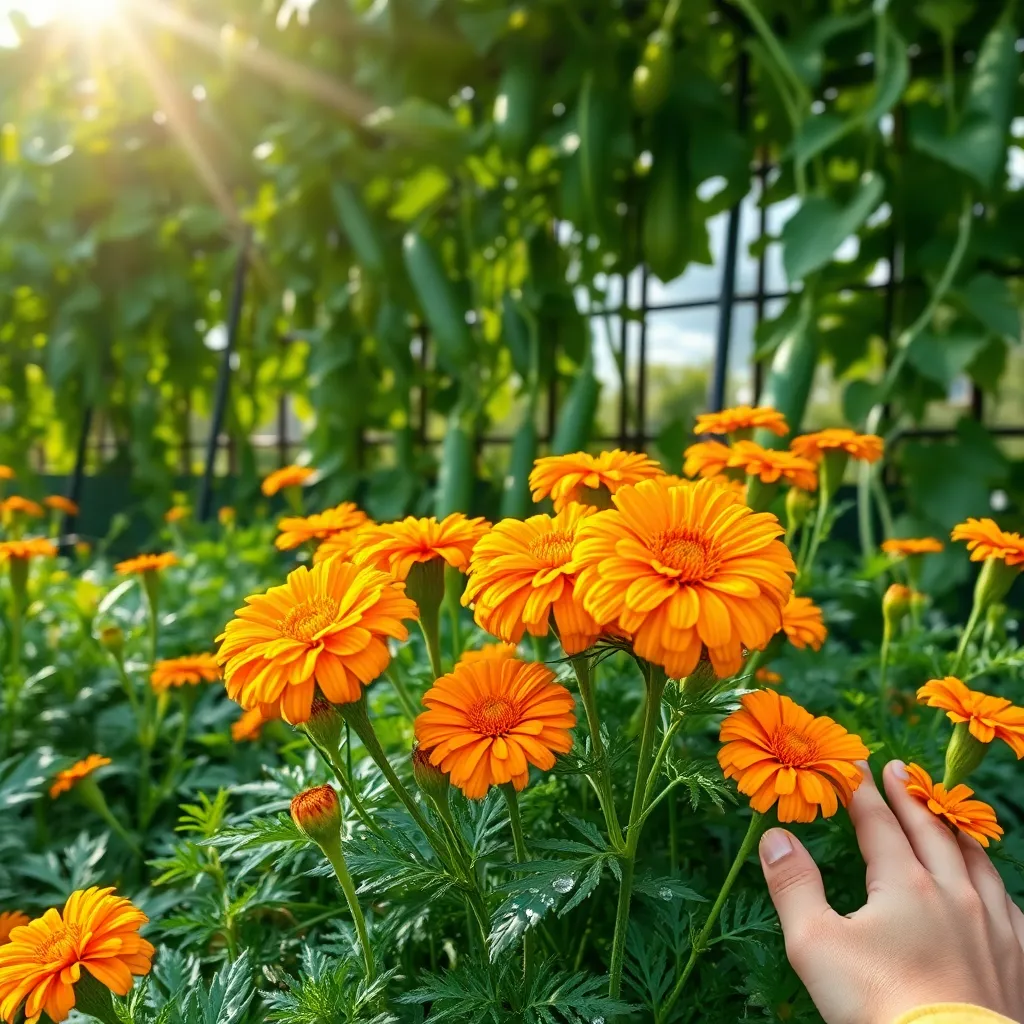
Marigolds are more than just vibrant additions to your garden; they are powerful allies in pest management. Known for their ability to repel nematodes and other garden pests, marigolds can help protect your cucumber plants from unwanted visitors.
To harness their pest-repelling power, plant marigolds around the borders of your cucumber beds. This creates a natural barrier that discourages pests from approaching your precious cucumber vines.
When planting marigolds, choose a location with full sun and well-draining soil. Ensuring they receive ample sunlight will promote robust growth and enhance their pest-repelling qualities.
Water marigolds consistently, allowing the soil to dry slightly between waterings to prevent root rot. This practice not only keeps the marigolds healthy but also maximizes their ability to keep pests at bay.
Nasturtiums (Aphid Attractors for Natural Pest Control)
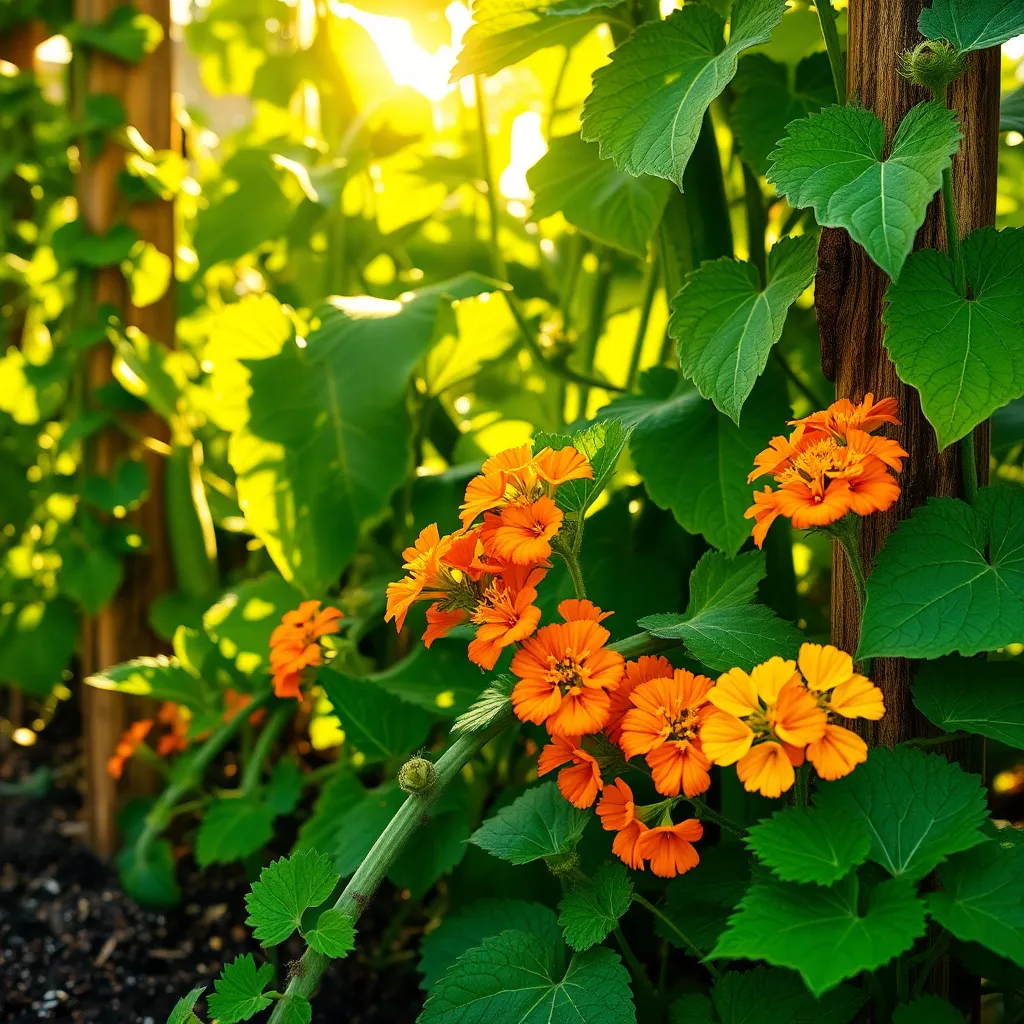
Nasturtiums serve as excellent companion plants for cucumbers by attracting aphids, which are then preyed upon by beneficial insects like ladybugs. This natural method of pest control can reduce the need for chemical pesticides, promoting a healthier garden ecosystem.
To grow nasturtiums successfully, plant them in well-drained soil with a pH between 6.1 and 7.8, ensuring they receive full sun to partial shade. While they are drought-tolerant, regular watering during dry spells will help them thrive, especially when paired with thirsty plants like cucumbers.
For gardeners looking to maximize the benefits of nasturtiums, consider planting them around the perimeter of your cucumber patch. This strategic placement acts as a trap crop, drawing pests away from your cucumbers and minimizing damage to your main harvest.
Advanced gardeners might explore using nasturtium leaves and flowers in salads, as they are both edible and add a peppery flavor. Incorporating these blooms into your kitchen not only adds culinary value but also encourages ongoing cultivation and care of these versatile plants.
Radishes (Root and Vine Space Savers)

Radishes make an excellent companion for cucumbers, as they help maximize space in the garden while maintaining healthy soil. Planting radishes near cucumbers can deter pests such as cucumber beetles, thanks to their natural repellent properties.
To start, sow radish seeds one inch apart and one inch deep, allowing them to grow swiftly and harvest in just 3 to 4 weeks. Cucumbers, with their sprawling vines, can comfortably share the space, as radishes will be out of the ground before the cucumbers need extra room.
Ensure your radishes receive plenty of sunlight, as they thrive in full sun with well-drained soil that’s rich in organic matter. For optimal results, keep the soil consistently moist but not waterlogged, which will help both radishes and cucumbers grow robustly.
Advanced gardeners can experiment with successive planting, sowing radish seeds every couple of weeks to maintain a continuous harvest and keep the soil lively. This technique not only provides a steady supply of radishes but also continuously benefits cucumbers by keeping pests at bay.
Dill (Pollinator-Friendly Herb)
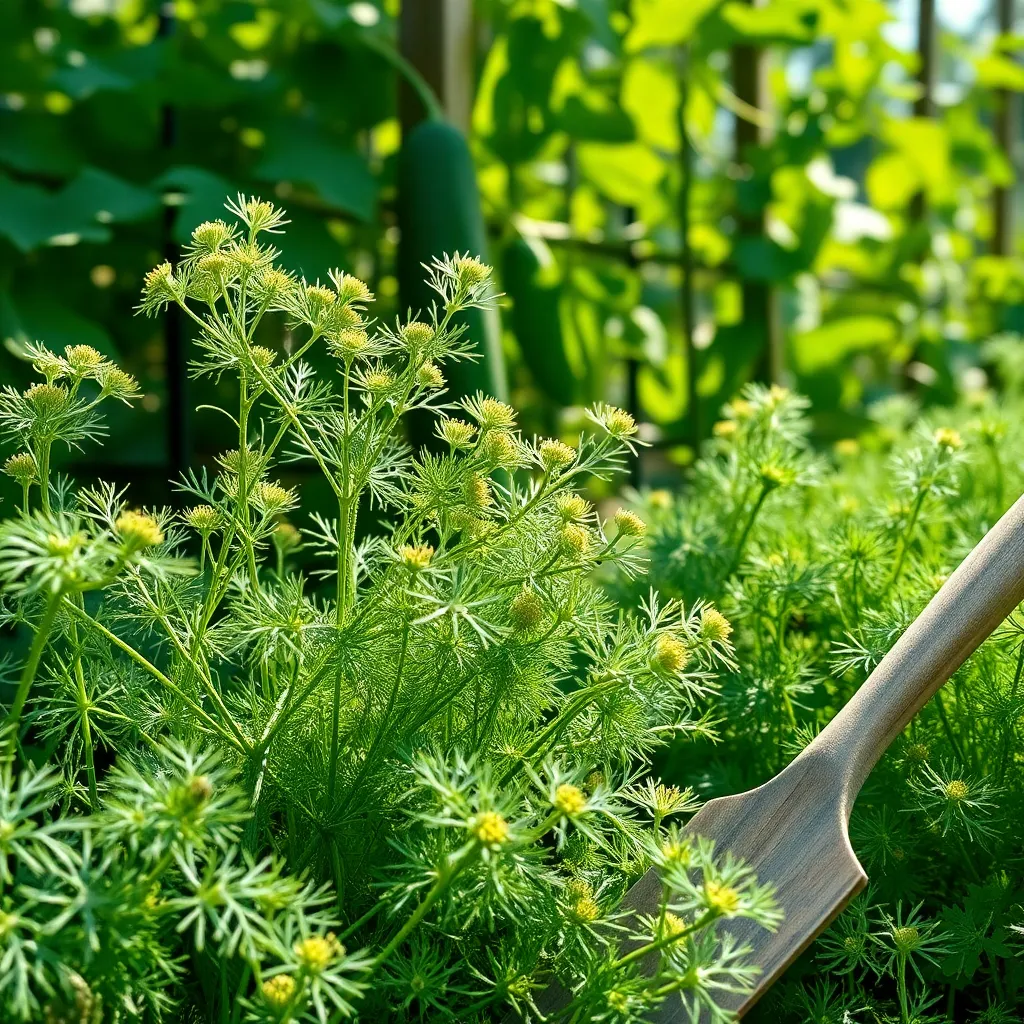
Dill is a wonderful companion plant for cucumbers, as it attracts beneficial insects like bees and ladybugs that help with pollination and pest control. This herb thrives in well-drained soil and full sun, making it an ideal choice for sunny spots in your garden.
For beginners, planting dill is straightforward; simply sow seeds directly into the soil after the danger of frost has passed. Keep the soil consistently moist but not waterlogged, as dill prefers a balance that supports its delicate roots.
More experienced gardeners can experiment with succession planting to ensure a continuous supply of fresh dill throughout the growing season. To do this, plant new seeds every three weeks, allowing for a steady harvest and ongoing attraction of pollinators.
Dill’s feathery foliage not only enhances your garden’s aesthetics but also serves as a natural mulch, helping to retain soil moisture around your cucumber plants. Additionally, maintaining a planting distance of at least 12 inches between dill and cucumbers can help prevent any competition for resources while still benefiting from dill’s positive effects.
Trellising Systems (Maximize Vertical Growth)
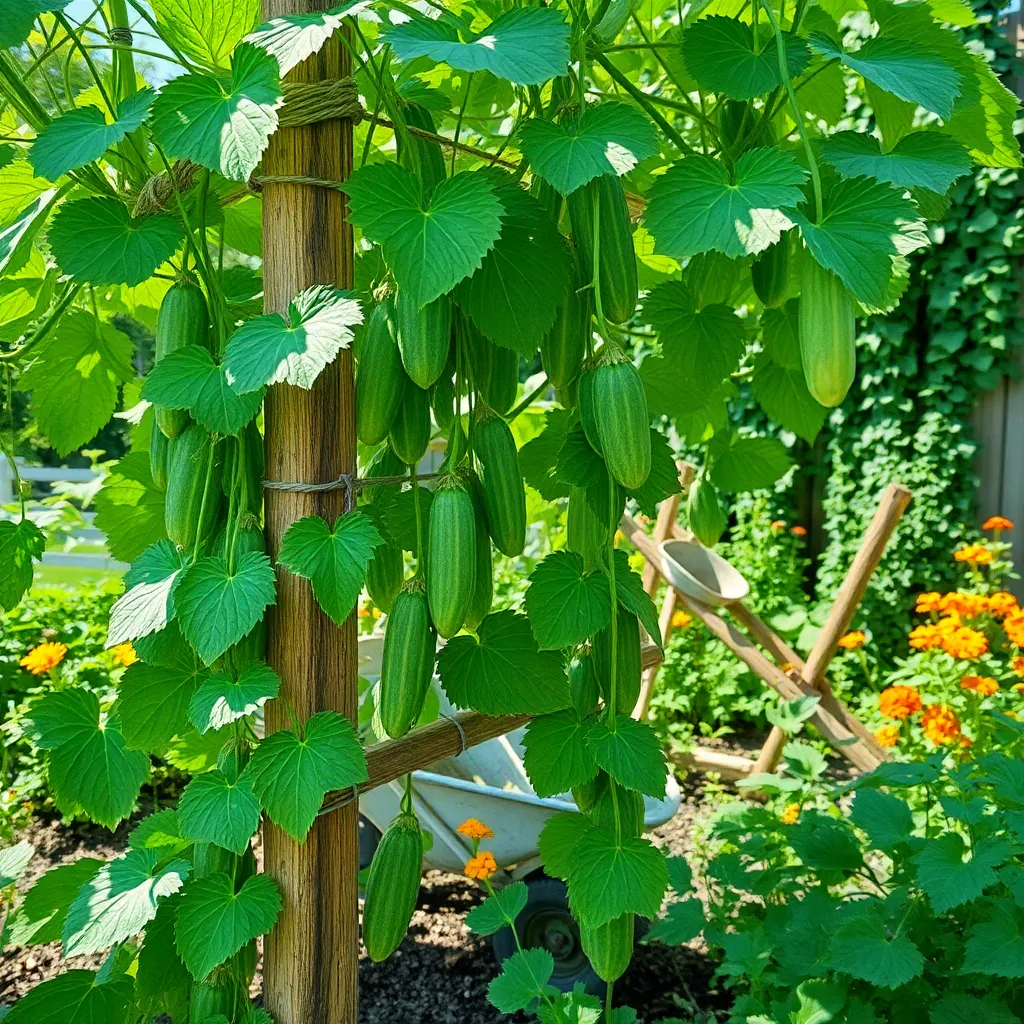
Utilizing a trellising system for your cucumbers can significantly enhance their vertical growth potential. By growing upwards, cucumbers not only save space but also improve air circulation, which helps reduce the risk of disease.
For beginners, a simple vertical trellis made from wooden stakes or metal poles can be highly effective. Secure the trellis in the soil around your cucumber plants and gently tie the vines as they grow, ensuring they have enough support.
Advanced gardeners may opt for an A-frame trellis, which provides ample space for vines to spread and promotes even exposure to sunlight. This method can lead to increased yields, as well-tended plants often produce more fruit.
Consistent watering is crucial for cucumbers on a trellis, as the elevated position can lead to faster drying of soil. Ensure that the soil remains moist but not waterlogged, checking regularly during warm, dry spells.
Conclusion: Growing Success with These Plants
In nurturing successful cucumber plants, five key companion relationships stand out: marigolds deter pests, radishes repel cucumber beetles, corn provides shade, beans enrich the soil with nitrogen, and sunflowers attract pollinators. Together, these plants create a harmonious garden ecosystem that supports the flourishing of cucumbers, much like positive relationships enhance our personal growth.
Your immediate next step is to assess your garden space and introduce one or more of these companion plants, tailoring your choices to the specific needs of your cucumbers. By doing so, you actively foster a more resilient and productive garden environment.
To ensure you have this valuable information at your fingertips whenever needed, save or bookmark this article. It will serve as a reliable guide as you continue to cultivate your gardening skills and grow thriving plant relationships.
Remember, just as in gardening, nurturing relationships in life requires intention and care. By investing in these connections, you pave the way for enduring success and bountiful harvests in both your garden and personal life. Let this article be your companion on this fruitful journey.

